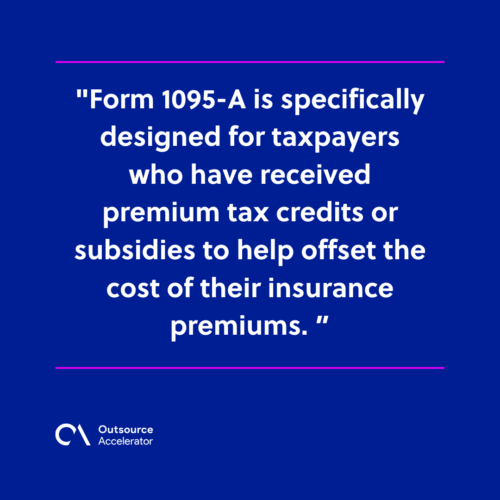The meaning of Form 1095-A

If you are one of the millions of Americans who purchased health insurance through the Health Insurance Marketplace or your state’s equivalent, then you likely received Form 1095-A.
As taxpayers gear up to fulfill their annual tax obligations, understanding Form 1095-A is essential to ensure accurate and timely submissions.
In this article, we will explain what you need to know about Form 1095-A and its vital role in the tax filing puzzle.
What is Form 1095-A?
Form 1095-A, often called the Health Insurance Marketplace Statement, is a document generated by the Internal Revenue Service (IRS). It contains information about those enrolled in a qualified health plan through the Health Insurance Marketplace.
Form 1095-A provides essential information for individuals seeking health coverage through the Affordable Care Act (ACA) marketplace.
The form serves as a detailed record of the insurance coverage, giving essential reports such as:
- Month of coverage
- Amount of any premium assistance received
- Details about the insurance provider
The purpose of Form 1095-A is to report these details so that individuals can:
- Take the premium tax credit
- Reconcile it on their tax returns with advance payments
- File an accurate tax return
Essentially, the form is there for you to report information about your health insurance coverage and any financial assistance you may have received to make coverage more affordable.
Form 1095-A is vital in accurately reporting healthcare coverage on the individual’s federal income tax return. It ultimately impacts the calculation of any owed taxes or refunds.

Who can file Form 1095-A?
Form 1095-A is filed by individuals and households who enrolled in a qualified health plan through the Health Insurance Marketplace. The marketplace itself supplies this form.
Form 1095-A is specifically designed for taxpayers who have received premium tax credits or subsidies to help offset the cost of their insurance premiums.
It’s important to note that anyone who purchased a catastrophic health plan or a separate dental policy (called a stand-alone dental plan) should not file Form 1095-A for those specific plans.
It’s highly recommended you refer to the information provided by the Health Insurance Marketplace to determine your eligibility for filing Form 1095-A.

When to file Form 1095-A?
When it comes to filing Form 1095-A, there are specific timelines and deadlines that individuals need to be made aware of.
The Health Insurance Marketplace typically sends Form 1095-A by January 31 each year. This applies to coverage in the previous calendar year.
Once taxpayers receive the form, they can use the information provided to complete their federal income tax return.
The deadline for filing federal income tax returns is generally April 15 of each year, but this can be extended to the next business day if it falls on a holiday or weekend.
You must receive Form 1095-A before filing your taxes. Its absence means you won’t have the necessary information to accurately report your health insurance coverage and any premium tax credits.
Filing taxes without this information may result in errors or delays in tax return processing.
How to file Form 1095-A?
To file Form 1095-A, you must submit the information to the IRS electronically. Here’s a general guide on how to file the form:
1. Obtain Form 1095-A
The Health Insurance Marketplace will deliver your Form 1095-A by January 31. Keep an eye on your mailbox or electronic communications to ensure you receive it on time.
If you also received advance payments of the premium tax credit, you’ll need to reconcile those payments on your tax return using Form 8962.
2. Review the information
Check the form for accuracy and make sure it includes all the correct information about your health plan. Check that the months of coverage, premium amounts, and any subsidies are accurately reported.
3. Calculate the premium tax credit
Use the information on the form to calculate the amount of your premium tax credit. You can refer to the IRS instructions for calculation.
4. File your tax return
File your taxes and include Form 1095-A to report your health insurance coverage and premium tax credit. Submit this by the April 15 deadline.
5. Retain a copy for your records
Keep a copy of Form 1095-A and any supporting documentation. Having these records on hand can be beneficial in case of any future inquiries or audits.
6. Seek professional advice if needed
If you find the process challenging or have specific questions, consider seeking assistance from a tax professional.
The particular guidelines for submitting Form 1095-A may change according to your unique situation. Be sure to also refer to the IRS instructions to ensure accurate reporting.

Stay compliant with Form 1095-A
Staying compliant with Form 1095-A is important to ensure that you accurately report your healthcare coverage and premium tax credit on your tax return.
The following tips can help you maintain compliance:
- Keep your healthcare enrollment information up to date. Ensure that your information with the Health Insurance Marketplace is accurate and up to date, including your income, household size, and other relevant information.
- Review Form 1095-A for accuracy. Scrutinize Form 1095-A to ensure it includes the correct information about your healthcare coverage and premium tax credit.
- File your taxes by the deadline. Be sure to file your federal taxes by the deadline and include Form 1095-A and Form 8962 if necessary.
You’ll be forgiven for finding the entire process challenging. Seeking assistance from tax professionals and utilizing tax preparation software can provide valuable support.
By following these tips and consulting IRS guidelines, you can stay compliant with Form 1095-A and accurately report your healthcare coverage.







 Independent
Independent




